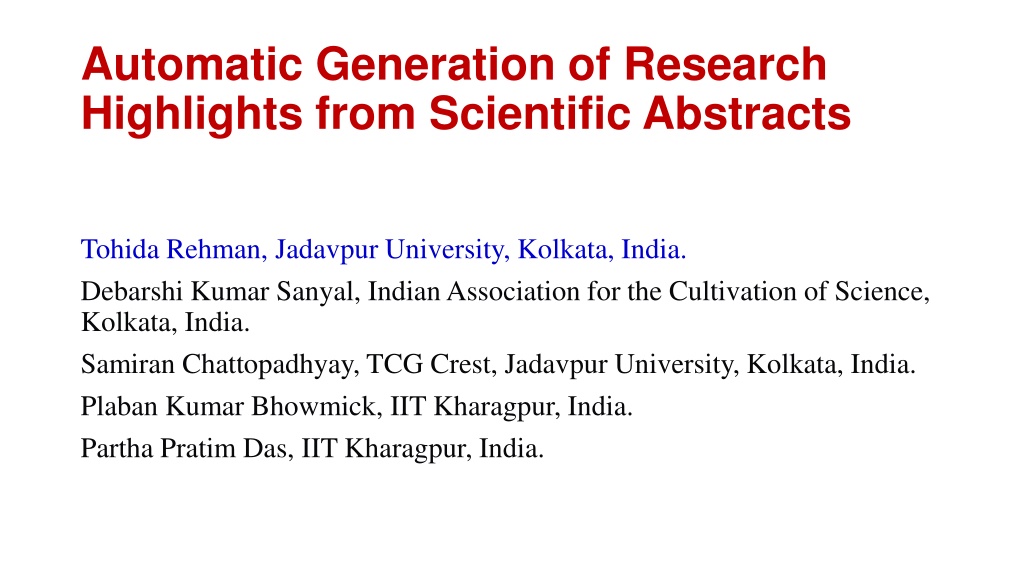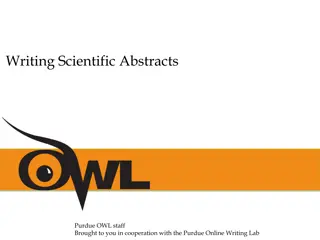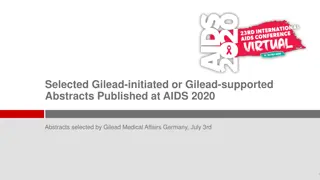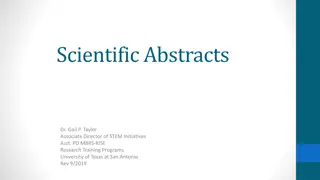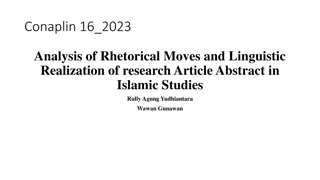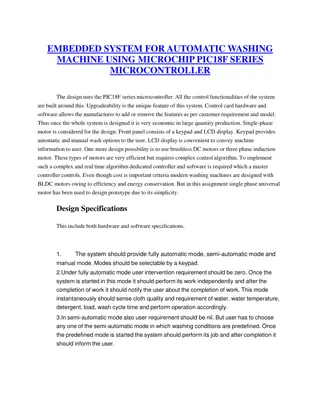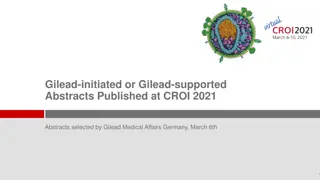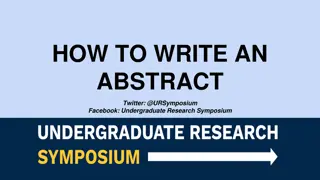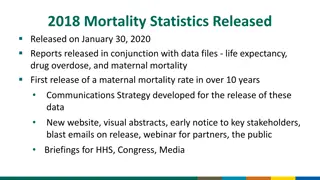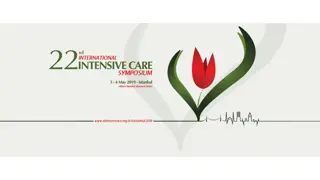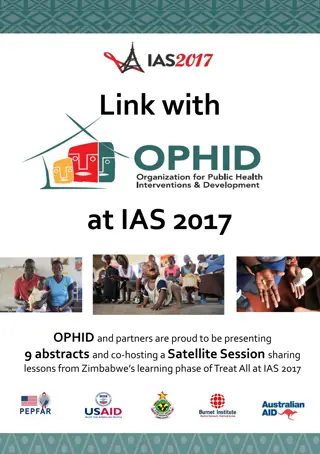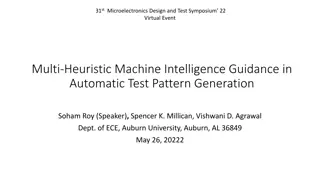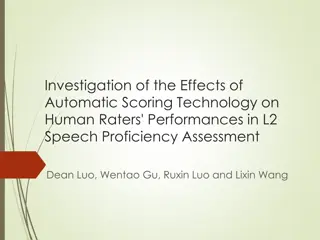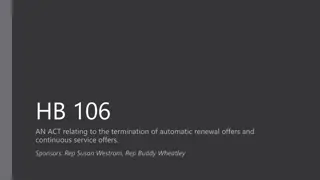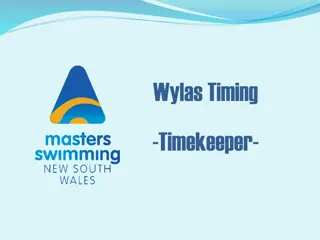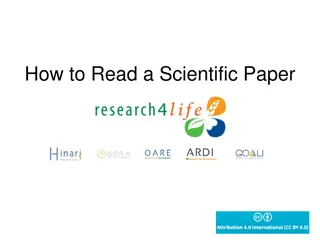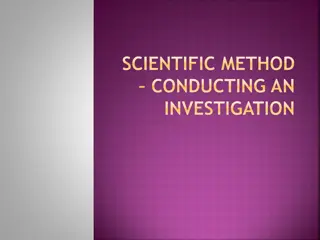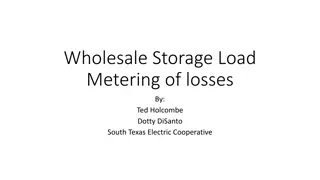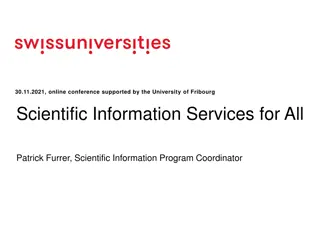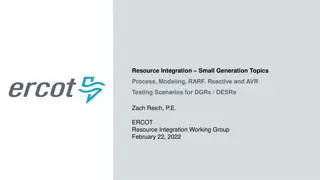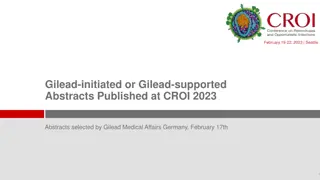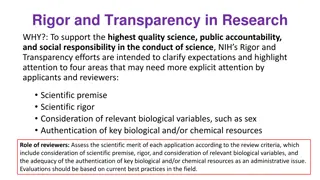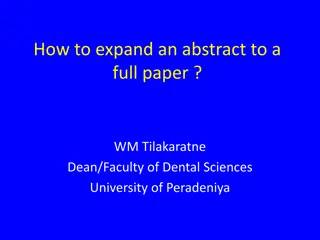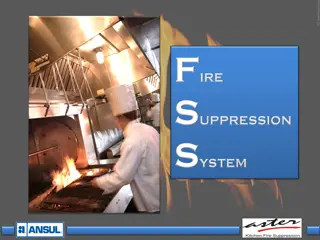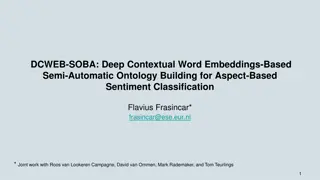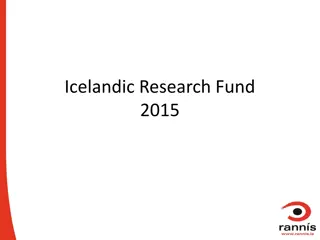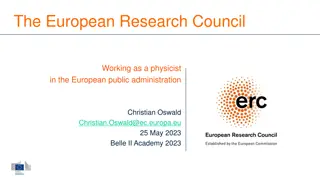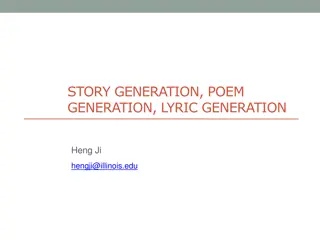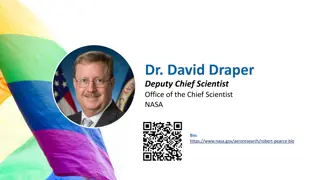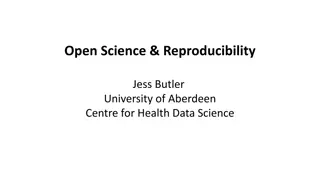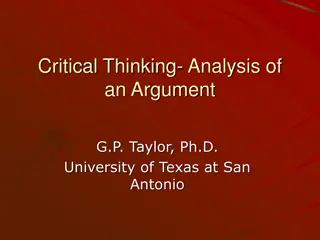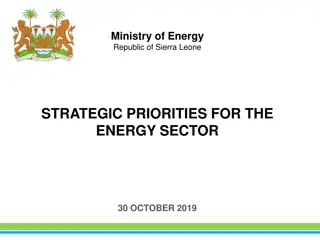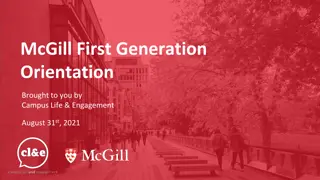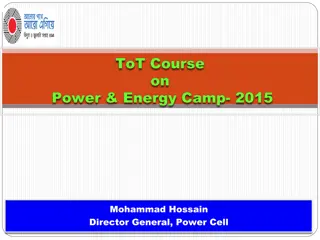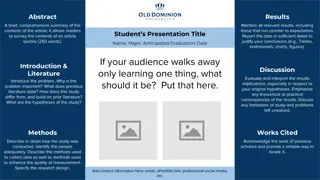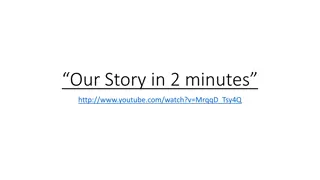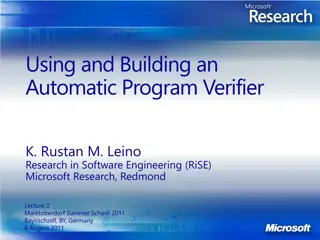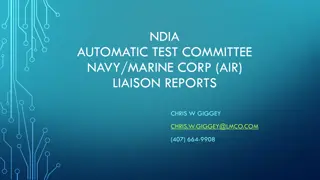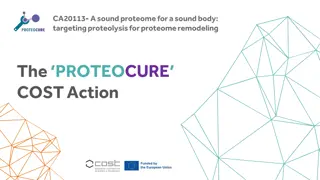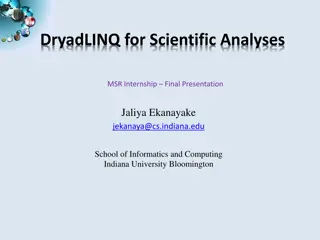Automatic Generation of Research Highlights from Scientific Abstracts
Huge growth in scientific publications has made it challenging for researchers to keep up with new research. This project focuses on automatically constructing research highlights from paper abstracts using deep learning models. The system employs sequence-to-sequence models with attention and pointer-generator networks to generate highlights. Evaluation results show the effectiveness of the pointer-generator network with coverage mechanism. Work is ongoing to enhance highlight predictions further.
- Research Highlights
- Scientific Abstracts
- Deep Learning Models
- Pointer-Generator Network
- Research Automation
Uploaded on Oct 02, 2024 | 0 Views
Download Presentation

Please find below an Image/Link to download the presentation.
The content on the website is provided AS IS for your information and personal use only. It may not be sold, licensed, or shared on other websites without obtaining consent from the author. Download presentation by click this link. If you encounter any issues during the download, it is possible that the publisher has removed the file from their server.
E N D
Presentation Transcript
Automatic Generation of Research Highlights from Scientific Abstracts Tohida Rehman, Jadavpur University, Kolkata, India. Debarshi Kumar Sanyal, Indian Association for the Cultivation of Science, Kolkata, India. Samiran Chattopadhyay, TCG Crest, Jadavpur University, Kolkata, India. Plaban Kumar Bhowmick, IIT Kharagpur, India. Partha Pratim Das, IIT Kharagpur, India.
Overview Huge growth of scientific publications makes it very difficult for researchers to keep track of new research even in narrow sub-fields. An abstract is a traditional way to present a high level view of the research paper. One recent trend is to provide research highlights a bulleted list of the main contributions. We aim to automatically construct research highlights given the abstract of a paper.
Dataset Details Used dataset (URLs) released by Collins et al.[2]. URLs of 10142 computer science publications from ScienceDirect. Dataset is organized as (abstract, author-written research highlights). Training : 8115 pairs. Validation : 1014 pairs. Testing : 1013 pairs. Average abstract size : 186 words. Average author-written research highlights : 52 words.
Workflow of our system Used 3 deep learning-based models to generate research highlights. 1. Sequence-to-sequence (seq2seq) model with attention [3]. 2. Pointer-generator network [8]. 3. Pointer-generator network with coverage mechanism [8] [9].
Evaluation Results ROUGE METEOR ROUGE-1 ROUGE-2 ROUGE-L Synonym/paraphrase/stem R P F1 R P F1 R P F1 R P F1 Final Score 20.90 20.47 19.90 02.02 02.02 1.93 19.49 19.16 18.58 17.86 17.69 17.78 7.39 Model 1 30.99 32.07 30.9 7.48 8.06 7.55 28.66 30.34 28.62 25.53 26.61 26.06 11.04 Model 2 31.6 33.32 31.46 8.52 9.2 8.57 29.2 30.9 29.14 27.64 29.26 28.43 12.01 Model 3
Comparison of model-generated Research Highlights Abstract taken from https://www.sciencedirect.com/science/article/abs/pii/S0168874X15000621 The meaning of the colors are explained in main text:
Conclusion The pointer-generator network with coverage mechanism achieved the best performance. But the predicted research highlights are not yet perfect. We are currently exploring other techniques to improve the system.
References [1] Dzmitry Bahdanau, Kyunghyun Cho, and Yoshua Bengio. 2015. Neural machine translation by jointly learning to align and translate. In ICLR. [2] Ed Collins, Isabelle Augenstein, and Sebastian Riedel. 2017. A supervised approach to extractive summarisation of scientific papers. In CoNLL. [3] Ramesh Nallapati, Bowen Zhou, Caglar Gulcehre, Bing Xiang, et al. 2016. Abstractive text summarization using sequence-to-sequence RNNs and beyond. In CoNLL. 280 290. [4] Jeffrey Pennington, Richard Socher, and Christopher D Manning. 2014. GloVe: Global vectors for word representation. In EMNLP. 1532 1543. [5] TYSS Santosh, Debarshi Kumar Sanyal, Plaban Kumar Bhowmick, and Partha Pratim Das. 2018. Surrogator: A tool to enrich a digital library with open access surrogate resources. In JCDL. 379 380. [6] Tokala Yaswanth Sri Sai Santosh, Debarshi Kumar Sanyal, Plaban Kumar Bhowmick, and Partha Pratim Das. 2020. DAKE: Document-Level Attention for Keyphrase Extraction. In ECIR. [7] Debarshi Kumar Sanyal, Plaban Kumar Bhowmick, Partha Pratim Das, Samiran Chattopadhyay, and TYSS Santosh. 2019. Enhancing access to scholarly publications with surrogate resources. Scientometrics 121, 2 (2019), 1129 1164. [8] Abigail See, Peter J Liu, and Christopher D Manning. 2017. Get to the point: Summarization with pointer-generator networks. In ACL. [9] Zhaopeng Tu, Zhengdong Lu, Yang Liu, Xiaohua Liu, and Hang Li. 2016. Modeling coverage for neural machine translation. In ACL. [10] Richard Van Noorden. 2014. Global scientific output doubles every nine years. Nature news blog (2014).
Contact Details Tohida Rehman, Email: tohida.rehman@gmail.com Debarshi Kumar Sanyal, Email: debarshisanyal@gmail.com Samiran Chattopadhyay, Email: samirancju@gmail.com Plaban Kumar Bhowmick, Email: plaban@cet.iitkgp.ac.in Partha Pratim Das, Email: ppd@cse.iitkgp.ac.in
